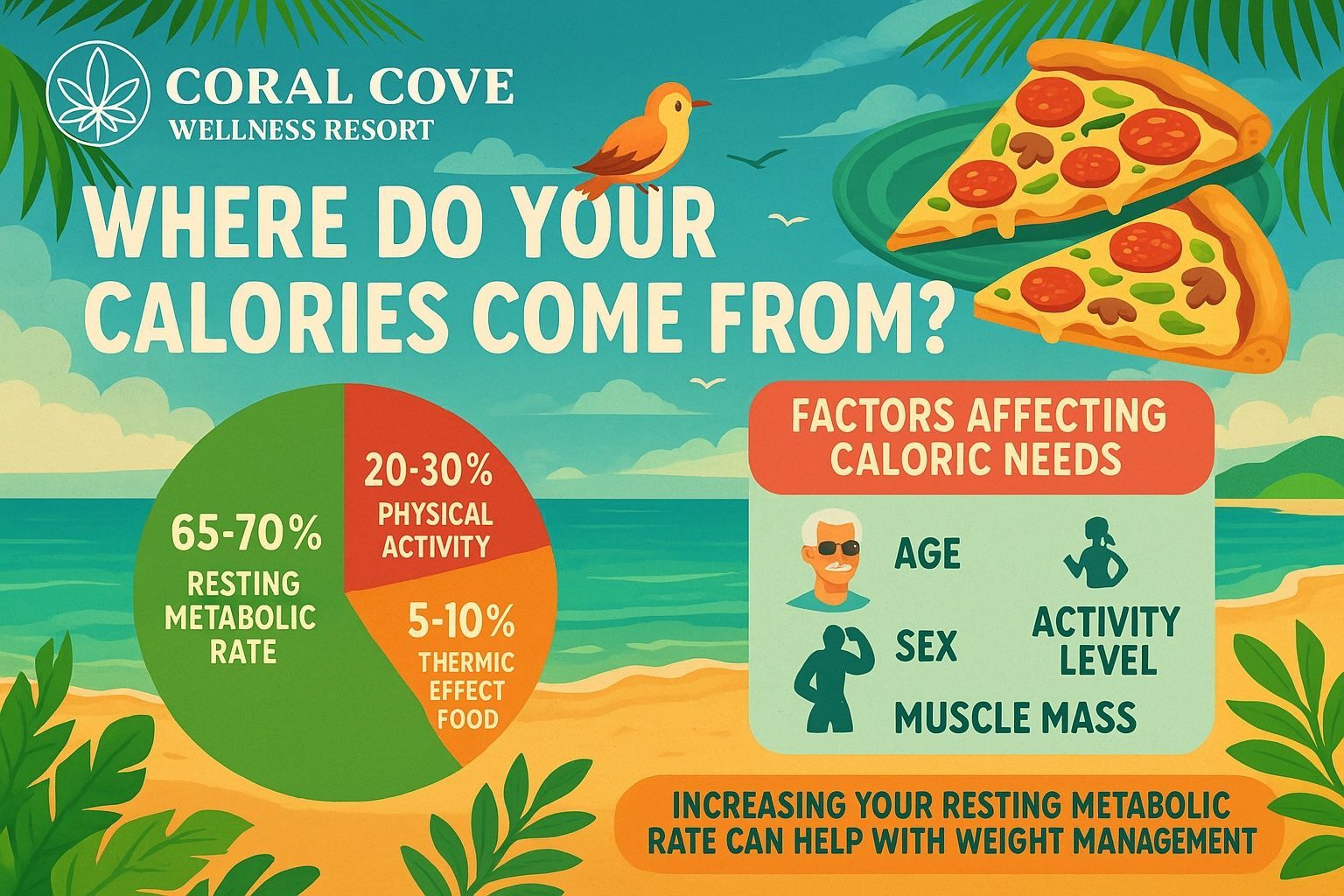Understanding Caloric Needs: Why Awareness is the First Step to Wellness
One of the most important — and misunderstood — foundations of health is understanding caloric needs. In my clinical practice, I have seen time and again that people drastically underestimate how many calories they consume, and at the same time, overestimate how many calories they truly need. This disconnect is one of the reasons so many people struggle with weight, energy, and long-term wellness.
Calories are not the enemy. They are the body’s fuel, essential for everything from brain function to digestion. But just as too little fuel leaves you depleted, too much can quietly and steadily push your body out of balance.
Why Caloric Awareness is Crucial
Your resting metabolic rate (RMR) — the number of calories you burn at rest — accounts for nearly 65–70% of your daily energy needs. What most people don’t realize is that RMR varies significantly from person to person. Two people of the same age, sex, and weight can have caloric requirements that differ by nearly twofold.
That means you cannot rely on “average” numbers alone. Your needs are personal — influenced by your sex, age, activity level, and especially your body composition. Muscle tissue burns more calories at rest than fat, which is why active individuals or those with greater lean body mass often have higher caloric needs.
The Pizza Problem: A Real-World Example
A recent study gave us a simple but eye-opening illustration: when young men were allowed to eat pizza until they felt “comfortably full,” they consumed about 1,600 calories in one sitting. When encouraged to eat until “really full,” their intake more than doubled to over 3,000 calories.
This is not about blaming pizza — it’s about recognizing how easy it is to consume an entire day’s worth of calories in a single meal without even realizing it.

Food Labels and the Deception of Portions
Complicating this issue further is the way food is packaged and labeled. Many labels show nutrition information for portions that don’t reflect how most of us actually eat. A “half cup” serving of cereal, for instance, may look tiny compared to the amount most people pour into a bowl. The result? Hundreds of extra calories consumed before the day even begins.
This is why awareness — not obsession — matters. If you at least have a ballpark idea of what your body needs and what your meals contain, you can make better, more conscious decisions.
Why Focusing Only on Exercise Calories Misses the Point
When most people think about “burning calories,” they picture the treadmill, a bike ride, or a high-intensity workout. Fitness devices and apps reinforce this by tracking exercise calories burned. But here’s the reality:
- Exercise typically accounts for only 10–30% of your daily energy expenditure.
- Resting metabolic rate (RMR) makes up 65–70% of your caloric needs — the lion’s share of your energy requirements.
In other words, the majority of your daily caloric burn comes not from workouts but from simply staying alive: breathing, circulating blood, maintaining body temperature, and running the trillions of cellular processes that keep you functioning.
That doesn’t mean exercise isn’t important. Movement supports cardiovascular health, muscle strength, flexibility, mental well-being, and longevity. But if you’re only focused on “calories burned in the gym,” you’re overlooking the bigger picture. True, lasting wellness comes from supporting your body’s baseline metabolism.
How to Increase Your Resting Metabolic Rate
The encouraging news is that you can take practical steps to influence your RMR. Here are strategies I recommend to both patients and wellness guests at Coral Cove:
- Build lean muscle mass
Muscle tissue is metabolically active. Strength training and resistance exercises help increase muscle, which in turn raises your resting calorie burn — even when you’re sitting still. - Prioritize protein
Protein requires more energy to digest compared to fats or carbohydrates (the “thermic effect of food”). Incorporating lean protein sources at each meal can modestly boost your metabolism while supporting muscle maintenance. - Stay active throughout the day
Beyond workouts, non-exercise activity thermogenesis (NEAT) — calories burned during everyday activities like walking, gardening, or taking the stairs — preserves metabolic function and prevents the “slowdown” seen in sedentary lifestyles. - Avoid chronic under-eating
Severe calorie restriction can cause the body to adapt by lowering RMR. Crash diets may lead to short-term weight loss, but they almost always reduce metabolism and make long-term wellness harder. - Get adequate sleep and manage stress
Poor sleep and chronic stress disrupt hormones that regulate metabolism, such as cortisol and thyroid hormones. Prioritizing rest, relaxation, and mindful practices can support healthy energy balance. - Don’t fear healthy fats
While fats are calorie-dense, they also promote satiety and support hormone production, both of which play roles in metabolism. Focus on whole-food sources like avocado, olive oil, nuts, and fatty fish.
Individual Factors That Shape Your Needs
Your caloric requirements are not static. Several personal factors must be taken into account:
- Sex – Men generally require more calories than women due to greater muscle mass.
- Age – While aging does influence metabolism, the effect is less than many assume. Still, older adults may need fewer calories simply because they are less active.
- Activity level – Exercise and daily movement can increase energy needs by 20–30%.
- Body composition – Muscle burns more calories at rest than fat, meaning leaner individuals often have higher energy requirements than those with higher body fat percentages.

Average Caloric Needs by Sex and Age: A Starting Point
While individual requirements vary widely, it can be helpful to understand the average resting metabolic rate (RMR) and daily energy needs across age and sex groups. Keep in mind these are broad estimates — your personal requirements may differ significantly depending on body composition, genetics, lifestyle, and health status.
- Men (average, resting needs only):
- Ages 18–30: ~1,900–2,100 calories/day
- Ages 31–50: ~1,800–2,000 calories/day
- Ages 51+: ~1,600–1,900 calories/day
- Women (average, resting needs only):
- Ages 18–30: ~1,500–1,700 calories/day
- Ages 31–50: ~1,400–1,600 calories/day
- Ages 51+: ~1,300–1,500 calories/day
These numbers represent resting metabolic demands — the calories your body burns simply to keep you alive, without considering activity, digestion, or exercise. Once you add movement and the thermic effect of food, total daily needs are higher, typically ranging from ~2,000–3,000 calories/day for men and ~1,600–2,400 calories/day for women depending on lifestyle.
The key takeaway? These figures are just ballpark guides. Two men of the same age and weight may differ by up to twofold in their RMR. That’s why awareness — not blind reliance on averages — is so important.
A Necessary Step Toward Wellness
Counting calories may not sound glamorous, but having even a rough awareness of intake is often the first step toward aligning your nutrition with your health goals. At Coral Cove, we emphasize that this is not about restriction — it’s about balance, mindfulness, and learning how to fuel your body in a way that supports both longevity and joy.
Wellness begins with awareness. When you understand your needs, you can make choices that honor your body — whether that means enjoying fresh tropical fruits, a nourishing island-inspired meal, or a mindful indulgence shared among friends.
References
- Owen, O.E. Resting Metabolic Requirements of Men and Women. Mayo Clinic Proceedings, 1988.
- Pellet, P.L. Food Energy Requirements in Humans. American Journal of Clinical Nutrition, 1990.
- American Journal of Clinical Nutrition. Pizza intake study on energy consumption and satiety.
- NIH. Estimating Daily Caloric Needs. Link
- American Heart Association. Caloric Needs Guide. Link



